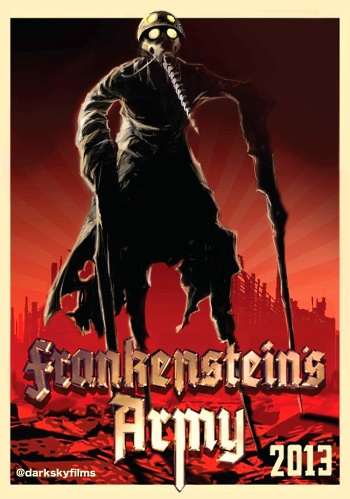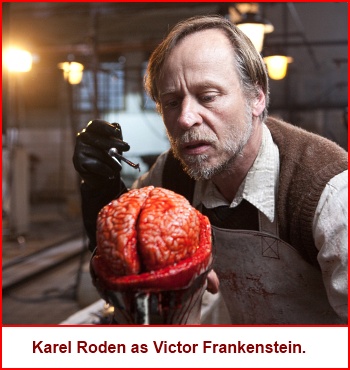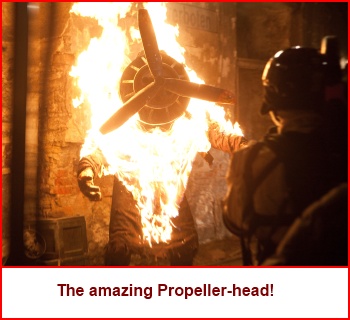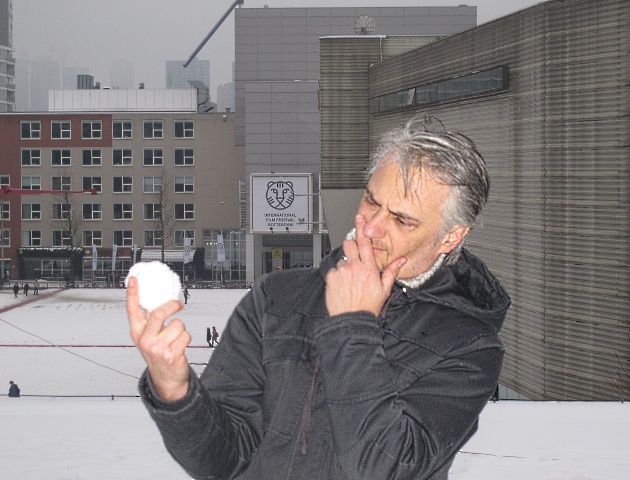IFFR 2013: A Talk With Richard Raaphorst About FRANKENSTEIN'S ARMY. Part 2 of 2: Shooting Zombots!

Here is the second part, which will focus more on filming Frankenstein's Army itself. Mild spoilers ahead, but nothing too bad. No deaths at least...
ScreenAnarchy: You had an amazing location, an abandoned mine, to shoot most of the film in. Last year I visited the set near Prague, in the Czech Republic, in... what was the name of that place again?
Richard Raaphorst: That was in the village of Mayrau.
When I was there I was also allowed into the creature workshop. And I was struck with how much care and attention went into the monsters, the amount of detail involved. I also saw many of your designs and sketches. You are a fantastic illustrator. So my first question is: will you be releasing an artbook? Because the first buyer sits here!
Thanks, and sure, if there is a big enough market for it we will release a book. In the finished version of Frankenstein's Army you only see about ten percent of the designs I made for it.
I saw so many cool things. Everybody loves Propeller-head, but you had drawn several different versions of him, with different nose-cones. One even had a shark head painted on it, like some Spitfires had in WWII.
Yes, yes. I really liked that idea but for the film we ended up using a different design.
I asked all the actors which creature was their favorite. I can tell you the end result...
Mosquito?
Indeed, even the guys who have a different favorite all add "... and Mosquito!". Well, not Todd: he just keeps saying Propeller-head. But what was yours?
 My favorite is Zompot.
My favorite is Zompot.
I thought they were all Zombots?
No, Zompot. The only one which is actually called "Zompot" in the designs is the walking wastepaper basket. "R2D2 from hell", we also called him. [we both laugh]
It's really the bottom half of [name removed because of spoiler], after he's been cut in two by [name removed because of spoiler].
That one is my favorite, because the design was so abstract. It was entirely developed towards its original idea, so much in fact that we managed to lose all the unnecessary add-ons.
He's certainly lovable, I took a picture of myself with Zompot when I was on the set. During the press screenings, everyone started to laugh when Zompot appeared. And then "Eva" comes along...
Eva is C3PO to Zompot's R2D2. She is C3PO mixed with some Bride of Frankenstein. In fact, C3PO was largely based on Maria, the female robot from Metropolis, so Eva is actually a direct mix of that robot and "The Bride".
Another one I loved was the real tunneling machine at the mine, the one you guys turned into a Death Tank or something...
That machine was really there, a leftover of the days when the mine was still active. We saw that thing standing in the field and we just HAD to do something with it.
But the whole mining location was fantastic. For me it was all a giant playground where I could really indulge in my fantasies. That place... I went completely Code Blue, allowed myself to go crazy with the designing. Take it as far as we could, within the time-frame we were allowed. I really squeezed that sponge until no drop was left in it.
What was diligently kept secret until the premiere is that Frankenstein's Army is shot in the "found footage" format. What was the reason for that, and was that decided at the scripting stage already or added afterwards?
No, the whole "found footage" idea was there from the start. After Worst Case Scenario stalled I wanted to do something different, as part of the 180 degree turn I felt I needed to do. And I wanted to change the perspective from subjective to personal. I wanted to make the audience feel like they were an accomplice to what the soldiers were doing in the war. I wanted to do away with any notion of "good" and "bad", and have the main character experience a situation, just as it is. Without any preaching. Just show the audience a slice of this and make them feel as if they were participating, partly responsible for what happens.
That's why I do not show any typical Nazi-horrors. You get to see plenty of normal Germans, while the Russian soldiers commit war crimes as well. People can make their own judgments, the horrors in the film are from war in general and Frankenstein's monsters, not from one side being evil.
The "found footage" combined with guns and monsters makes the film look a lot like recent video games at times, especially the First-Person-Shooter ones. Did you use video games as a source of inspiration?
Well... I did look at those, but I used them primarily to learn what NOT to do. Video games were useful to determine which things destroyed the sense of authenticity, and which things did not. I wanted to give Frankenstein's Army a game-like sheen for the latter parts, as I also wanted the film to be an attractive one. It starts out really rough-looking but becomes more slick and polished towards the end.
First-person games are of course REALLY interactive, they really involve the people playing them. To give our audiences a sense of immersion, of really being there, we did add a few elements to make it a bit like such a game.
But a game is a game, and this is a film. Games definitely did influence me on how to use the first-person aspect, but making it work in a film context was really interesting to me. I tried using those influences to make the film more... intimate.
But weren't there moments when the found-footage aspect was a big hindrance? At the set I saw the practical effects being tested for one of Mosquito's attacks, and they looked so awesome that I wondered if a traditional action scene might not have showed those off a lot better.
Yes, you win something in some scenes and you lose something in some scenes. But this was necessary to what I wanted to show, and the build-up to the end.
 Speaking of build-up: everybody I spoke with after the press screening loved the ending. It's just so different from the rest of the film.
Speaking of build-up: everybody I spoke with after the press screening loved the ending. It's just so different from the rest of the film.
Yes, it has an entirely different flow, with the "one-taker" at the end. I worried most about the beginning, I know most people think that the beginning is too slow, and too long. I just hope everyone will hang on to the middle part.
Well, it's a fairly short film...
Yes, but if I hadn't done the beginning like that, I wouldn't have had any build-up. I wanted Frankenstein's Army to have this build-up, it consist of obviously different parts. The beginning is a war movie, the middle siege part is horror, and the last part is a descent, a downward spiral into total madness. I mean, it would have been fun to start with madness already but I wouldn't have had anywhere to go from there.
I also want to praise Karel Roden here, because he becomes more important as the film moves on. Halfway through I was disappointed and thought he had nothing much to do, but when he reappears he manages to elevate the material to a higher level in my opinion, especially in the finale. It looked like he was having a lot of fun!
Yes, and that was on purpose.
Was he as enthusiastic during the shoot? When I met him on the set he was very serious, he seemed so reserved... somber even.
No, Karel Roden is an ehm... a firecracker. The moment you light his fuse he'll explode. He manages to retain his energy very long, to keep it all to himself, but when the moment arrives to use it, he blooms and gives all. He is such an experienced actor that he is able to keep his best moments for when the cameras are rolling, when it's needed the most. We also had several less experienced actors on set, and you could see how sometimes they had given their best in rehearsals already. They were then spent during the actual shoot, unable to get to the level of intensity they had reached earlier. But that didn't happen with Karel. He always delivered.
Karel as Victor seems so gleeful... so happy telling about his work.
That was exactly what we were aiming for. We needed an enthusiastic... not really an idiot mucking about, but more like an overenthusiastic car mechanic showing people how he fixes an old-timer. [we both laugh]
You know the type? "Look at this one! And this, and these!" He's using inherited knowledge and is so happy the notes he got are accurate. He himself is not brilliant, but he manages to make it all work, if barely sometimes, and he manages to keep it running.
He's making "toys for boys", war toys, and his father happened to be the toy manufacturer. So we wanted Karel to show Victor also as a child that plays with these war toys, to add that aspect to him.
 And I am so happy with the result. Most films, especially horror films, have such a recognizable story arc that the tension leaves at the end. We aimed at giving Frankenstein's Army an ending which suddenly went all the way up. But it's a pity the beginning seems to try people's patience so much.
And I am so happy with the result. Most films, especially horror films, have such a recognizable story arc that the tension leaves at the end. We aimed at giving Frankenstein's Army an ending which suddenly went all the way up. But it's a pity the beginning seems to try people's patience so much.
Well, audiences often leave screenings with a feeling based on the final moments. As such, this film's final moments ought to make most people happy.
And note that those moments are one long take.
Ah yes, you mentioned a "one-taker"...
From the moment that the camera is [description deleted because of spoiler] it is one shot of four minutes! I cannot recall another film that ends with such a long take.
Caché by Michael Hanecke?
Oh, ehm... yes, could be.
But I'm being a bit mean here because that is a fixed camera shot, and it's the closing credits as well.
My point is that most films up the tempo at the end, with shorter shots, machine-gun editing, fireworks, more, more, moremoremore...
So I thought let's go the other direction, see what happens. Peel off element after element, toss several things away until just the heart is left.
But you're doing that in the film's most amusing location, with plenty to see in the background. You're finally giving the audience a good look at some of the things we saw whooshing past earlier in the film.
I loved playing with that contrast, the camera becoming more of a static object, just recording what happens in front of it instead of being used as a subjective device. To try and keep it fresh by changing that perspective. Or changing the "tableau". Or changing the "palette".
That approach I learned from drawing storyboards for years. When you do a presentation for someone, you need to start strong and you need to end strong. Try and keep your audience awake by shaking them up once in a while. Try and beat predictability.
But damn, it was hard with Frankenstein's Army, we worked so long to get the ending just right. Two days before we shot that big "one-taker" we were still tweaking the story and actions in it, ironing out the final act. And it has now become something organic.
The shoot ended in April 2012 and we're now at the premiere in January 2013. Did you need to change much in post-production? Extra shots and such? People who needed to come back?
No, nothing like that thankfully. After the initial editing we did some re-editing, but that was it. The film is almost entirely as written in the script. We did add two shots and one extra Zombot creature, and that was a change I was in favor of.
When you saw the end result taking shape, did you ever think that you had gone too far, that the film was too gory perhaps?
No. I never took that into account, not for a second. At least I never worried about that.
Were there any creatures, a super-monster, that you wanted to put in the movie but had to cancel? One you regret for not being in it?
No, what we had put in the script we were able to film. The last and most expensive monster we had to fight to retain was Propeller-head. For a while it looked like there wasn't going to be enough stretch in the budget to allow us to include Propeller-head, but in the end we got clearance to put him in.
And that was the end of the interview. We discussed several other items during the photo-shoot, like details, spoilers, and the possibility of a sequel. But mentioning this here would be a bit too spoilery.
Again thanks go to Richard, and also to the IFFR press-desk for arranging this interview.


Do you feel this content is inappropriate or infringes upon your rights? Click here to report it, or see our DMCA policy.






